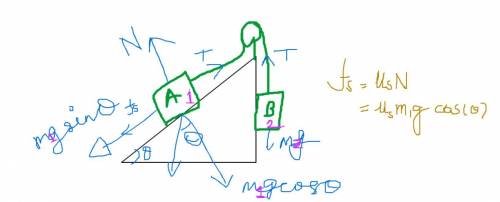
Physics, 31.03.2020 01:28, dianacastro8298
Block A, with a mass of 10 kg, rests on a 35 incline. The coefficient of static friction is 0.40. An attached string is parallel to the incline and passes over a massless, frictionless pulley at the top. What is the largest mass MB, attached to the dangling end, for which A remains at rest?

Answers: 3
Other questions on the subject: Physics

Physics, 21.06.2019 22:30, mirellaenriquez5529
Follow these directions and answer the questions. 1. shine a pencil-thin beam of light on a mirror perpendicular to its surface. (if you don't have a laser light as suggested in the video, you can make a narrow beam from a flashlight by making a cone from black construction paper and taping it over the face of the flashlight.) how does the light reflect? how does the relationship of incident to reflected ray relate to the reflection of water waves moving perpendicular to a barrier? 2. shine a pencil-thin beam of light on a mirror standing on a sheet of paper on the table (or floor) so that you can mark the incident ray and reflected ray. (you can support the mirror from the back by taping it to a wooden block.) 3. mark a line on the paper representing the reflective surface. (the reflective surface of a mirror is usually the back edge.) 4. draw a dashed line perpendicular to the mirror surface at a point where the incident and reflected ray meet. this perpendicular is called a normal to the surface. 5. measure the angles between the rays and the normal. the angle of incidence is the angle formed by the incident ray and the normal to the surface. the angle formed by the reflected ray and normal is called the angle of reflection (r). what is the angle of incidence? what is the angle of reflection? 6. repeat for several different angles. (see report sheet for details.) what appears to be the relationship between the angle of incidence and angle of reflection? in science 1204, what was the relationship for these two angles made by the reflection of waves in a ripple tank? 7. roll a ball bearing so that it hits a fixed, hard surface (a metal plate) at several angles (including head-on). observe the way in which the ball bearing reflects. what generalization can you make about how a ball bearing reflects from a wall? have you proved that light can only behave like a wave?
Answers: 1

Physics, 22.06.2019 10:50, afonseca73
Asheet of steel 1.5 mm thick has nitrogen atmospheres on both sides at 1200oc and is permitted to achieve a steady-state diffusion condition. the diffusion coefficient for nitrogen in steel at this temperature is 6 x 10- 11 m2 /s, and the diffusion flux is found to be 1.2 x 10-7 kg/m2 -s. also, it is known that the concentration of nitrogen in the steel at the high-pressure surface is 4 kg/m3 . how far into the sheet from this high-pressure side will the concentration be 2.0 kg/m3 ? assume a linear concentration profile.
Answers: 3

Physics, 22.06.2019 15:10, deidaraXneji
In the circuit, the switch s has been open for a long time and r = 125 kohm. it is then suddenly closed. (a) determine the time constant before the switch is closed. s (b) determine the time constant after the switch is closed. _ s (c) let the switch be closed at t = 0. find the current in the switch as a function of time. (use t for time. express your answer in milliamps and seconds.) i(t) =_
Answers: 3

Physics, 22.06.2019 15:30, Christyy1837
What are the similarities & differences between a thermistor and a light dependent resistor in physics?
Answers: 2
Do you know the correct answer?
Block A, with a mass of 10 kg, rests on a 35 incline. The coefficient of static friction is 0.40. A...
Questions in other subjects:



Mathematics, 07.02.2022 17:50


Mathematics, 07.02.2022 17:50

Mathematics, 07.02.2022 17:50



German, 07.02.2022 17:50

History, 07.02.2022 17:50


 = 10 kg
= 10 kg = 0.4
= 0.4 = 35°
= 35°  .
. ...(i)
...(i) ...(ii)
...(ii) 
 ...equation (iii)
...equation (iii)
 ...equation (iv)
...equation (iv)

![m_2=10[sin(35)+0.4cos(35)]](/tpl/images/0572/2987/2feae.png)
 kg
kg kg
kg , attached to the dangling end, for which
, attached to the dangling end, for which 




